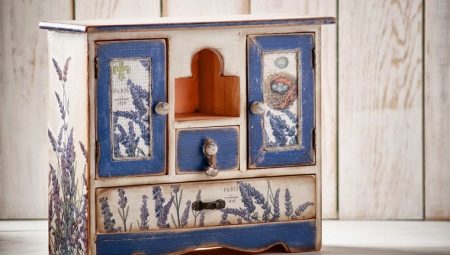Decoupage of old furniture with their own hands is the perfect solution for those who want to create an unusual and expressive interior, emphasizing the bright individuality of the owners. You can make furniture this way with your own hands, because there is nothing complicated. Today we will analyze in detail how to independently decoupage furniture and in what environments it will turn out to be a wonderful decoration.
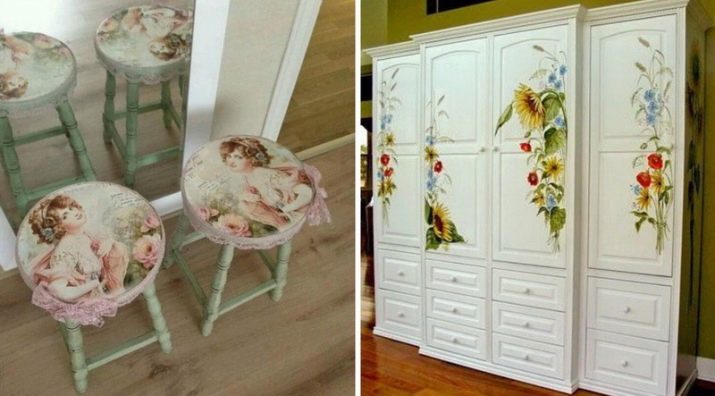
What is decoupage?
Today, people have many opportunities to beautifully decorate their home. A wide variety of attractive decorative materials, various decorations and designer items are presented to consumers' choice. However, many owners prefer to give the interior a more interesting and original look, turning to the decoupage technique. We will examine in detail what it is.
So, decoupage is a popular and easy way to decorate old furniture or other household items. Available materials are used here, for example, glue, paper, paints and various decorative inserts. With such elements, you can decorate the wooden structure with papier-mâché decorations, glass or rubber details. There are a lot of options, it all depends on the imagination of the master, who is engaged in furniture design.
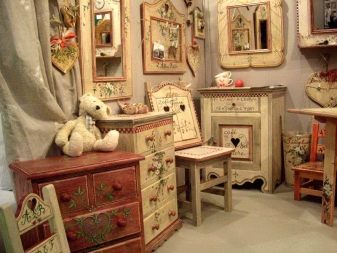
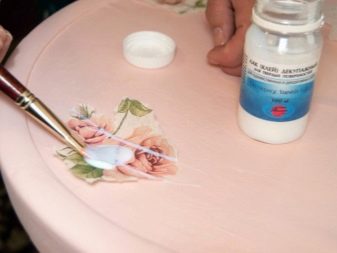
It is only necessary to take into account the fact that not all surfaces are designed for decoupage. Therefore, it is unlikely that it will be possible to design structures made from a material such as plastic. That is why it is important to carefully study the design that you plan to process, as well as properly prepare it.
Necessary materials and tools
Decoupage furniture is not as difficult to do as it might seem at first glance. In carrying out such events, it is very important to prepare all the necessary materials and tools. It is advisable to do this in advance - before the start of all work, so that you do not have to hurry to look for the right thing, spending extra time. It is recommended that you keep several necessary items in your arsenal.
- Small sharp scissors. In this case, it is permissible to use simple manicure scissors or special tools for tapestries. It is important to ensure that the blade is short and fairly sharp. Experienced craftsmen recommend using special scissors with Teflon coating. These tools do not corrode. In addition, paint and other foreign materials do not stick to them.
- Scalpel or special knife with a rotating blade. These tools are indispensable when it comes to processing materials with a dense structure.
- Several types of brushes. You will need brushes for laying the adhesive composition, varnish. It is advisable to use synthetic options having different thicknesses. Sometimes foam sponges are used.
- Primer. It will be needed to prepare the surface. It is permissible to use PVA glue or putty with acrylic.
- Glue. This product must be selected carefully. The glue should be special - for decoupage (for tight applications), PVA, wallpaper, paste, egg white, acrylic-based varnish.
- Background paints. Most often, acrylic paints, pastels or various pigments are put into use here.
- Roller. This tool cannot be dispensed with when it comes to smoothing the selected image applied to furniture.
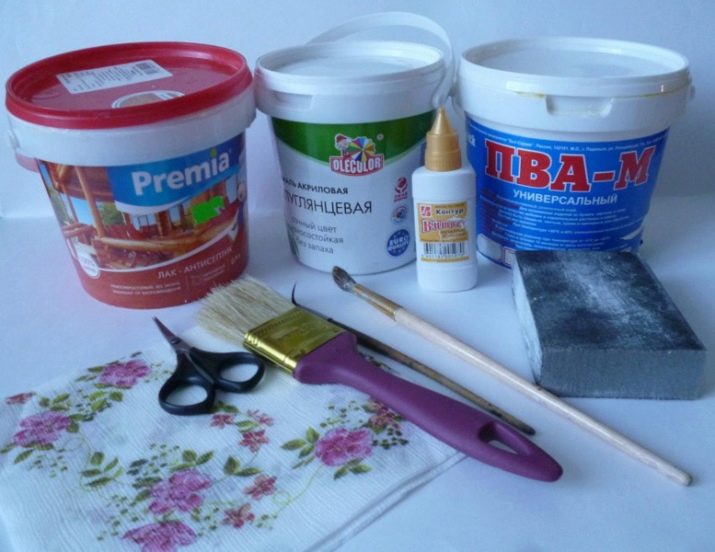
As for decoupage materials, you will need several items.
- Napkins. Everyone has access to material that is recommended for beginners to use. It will turn out to find special items in stores, but you can buy ordinary sets of four-layer napkins with attractive pictures and drawings.
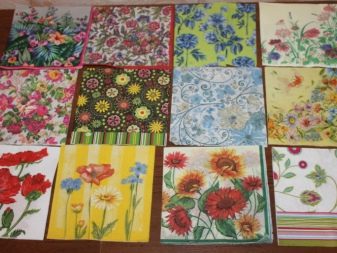

- Decoupage cards. These components can be found in stores. They are multidimensional drawings arranged in sets on a specific topic.
Since these elements are designed exclusively for decoupage, the materials from which they are made fully meet all the requirements of the mentioned technology - they are elastic, they cannot be torn just like that, and upon contact with water their shape remains the same.
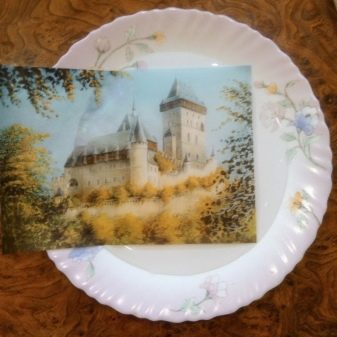
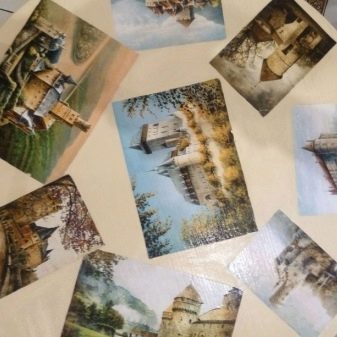
- Mulberry, rice or banana paper. These are special fibrous materials that are usually used to effectively decorate transparent surfaces. Such paper is not cut with scissors - drawings need to be carefully and carefully torn off by hand. Due to the characteristic texture, these materials are not torn and perfectly copy all the outlines of the base. Working with mulberry, rice or banana paper is simple and convenient.
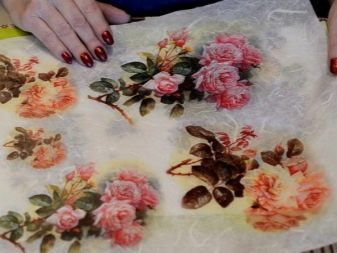
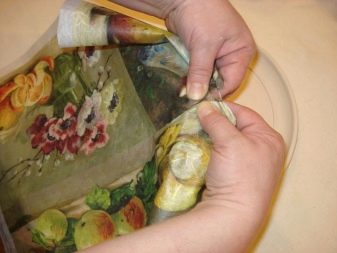
- Printouts. If you want to create a truly unique and original interior detail, then you can use this material. To this end, the printer prints your favorite prints. You can use cheap paper or even tracing paper - these options will absorb the coloring pigment.
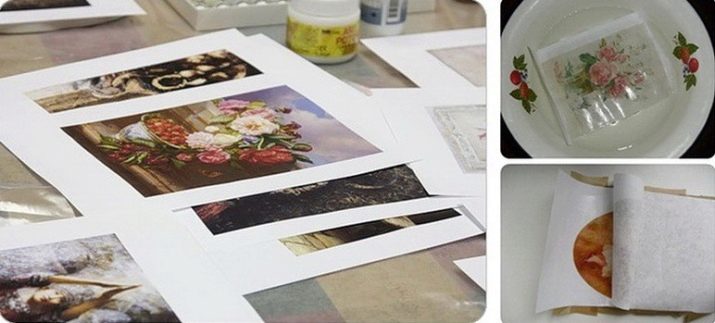
For decoupage of furniture designs, it is also acceptable to choose attractive wallpapers with various prints and pictures, fabric (for example, tulle), lace, various stickers. If you have chosen a similar technique for decorating furniture, then you can use a huge amount of materials. A lot in choosing the necessary components depends on your wishes and preferences.
Style selection
Before embarking on decorating furniture in your home, you need to figure out what styles decoupage can be done.
- Provence. This charming stylistic trend came from France.A characteristic feature of Provence is bleached backgrounds and patterns / patterns / prints made in pastel colors. Very often, masters decorate such compositions with original craquelure. Floral prints are also useful.
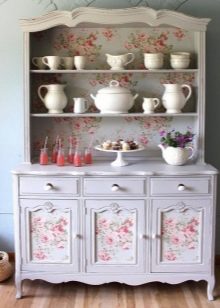
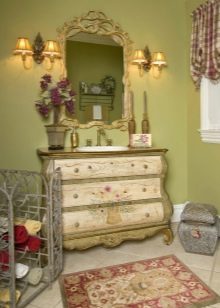
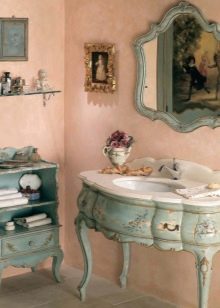
- Simple City. It will be possible to achieve design in this interesting style if you use the de-patch technique. In this case, newspaper clippings with torn edges are used. Old photographs will do.
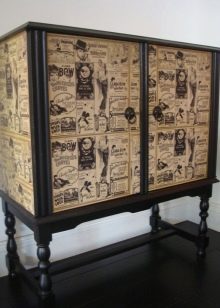
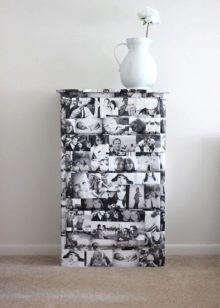
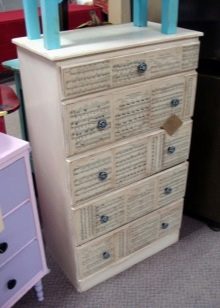
- French vintage. The main feature of this spectacular style is the design using two main colors.
Especially attractive decoupage in this style looks on old chests of drawers, countertops and other similar objects.
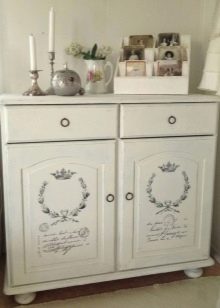
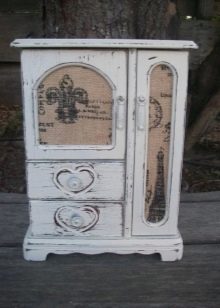
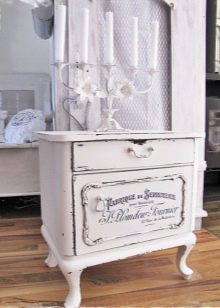
- Shabby chic. This is another terribly popular style, emphasizing the bright personality of the homeowners. Decoupage made in this direction makes the surface of a certain object very similar to antiques. There may be slightly blurry lines, edges with scuffs.
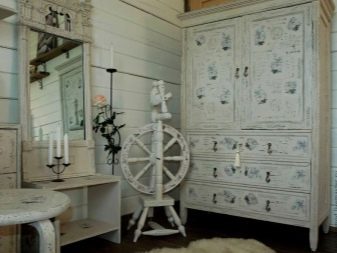
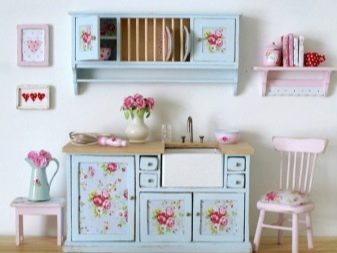

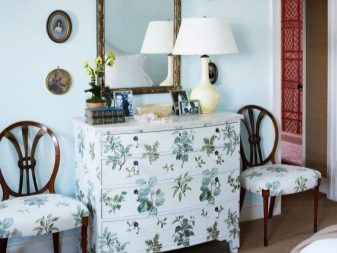
- Victorianism. This is a luxurious style that is difficult to confuse with other areas. To decorate furniture in this way, you need to have certain skills and experience. The main distinguishing features of this style: a combination of golden, blue, green colors. The theme of decoupage can be this: still life, hunting, flower bouquets, animals.
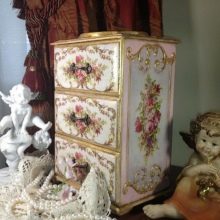
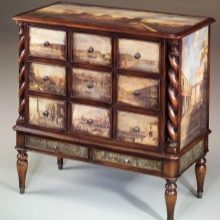

General principles of work
Furniture can be decorated using decoupage technique with your own hands. Such processing in most cases is performed without unnecessary problems. Of course, a lot depends on the actions of the master himself. It is very important to adhere to the instructions and correctly prepare the product.
- If you plan to design a structure made of glass, then it will first need to be properly degreased. For this purpose, the glass will need to be washed, dried, and then wiped with a cloth without lint. After that, a degreasing agent for washing dishes, but without coloring components, is applied to the glass.
- If tin surfaces are formed, then they will need to be treated with a composition based on water and vinegar. These components will need to be diluted in a ratio of 1 to 1. After washing in vinegar water, the tin surface is treated with a metal brush. Having removed all the stains, the brush will remove the layer from above.
- If you plan to work with wood or laminated particleboard, then these materials will need to be sanded using sandpaper (fine-grained).
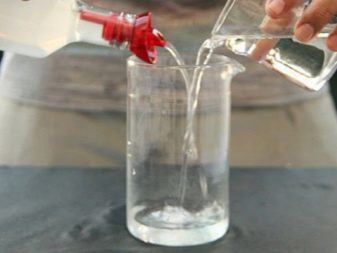
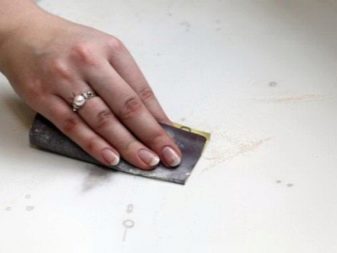
Further restoration can take place using any materials. For example, many people give an original look to old furniture designs using wallpaper. Let's analyze the general principles of furniture processing using the example of a table. This process is as follows:
- furniture is first prepared depending on the material from which it is made;
- the table needs to be washed, repaired, removed defects;
- then all surfaces are treated with a primer mixture;
- the table needs to be ground, especially carefully working at the edges;
- then the furniture must be covered with gray graphite paint;
- boxes are measured on the side of the facades;
- then rectangular parts from the wallpaper are cut in accordance with the measurements taken;
- when the finish dries, the top of the facade should be varnished.

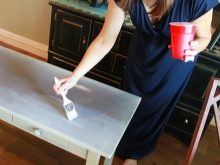
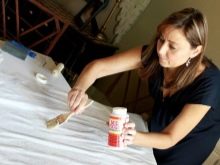
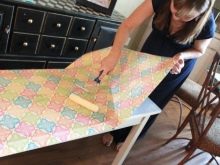
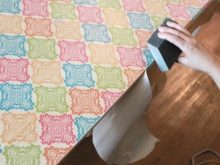
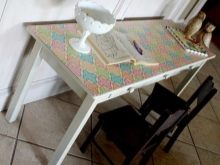
Decorating workshops
With your own hands you can make decoupage of a variety of furniture. It can be not only a table, but also an old chest of drawers, a curbstone, a whatnot, kitchen designs and many other objects. Let's take a step-by-step look at several workshops on self-processing furniture. These instructions can be very useful for beginners.
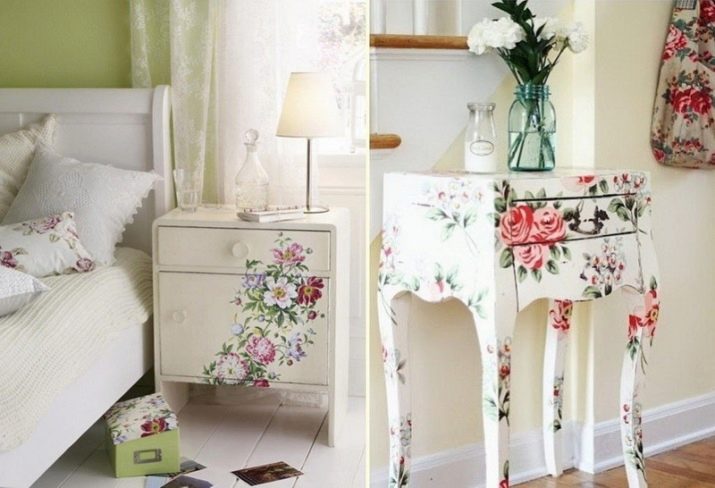
An old chest of drawers You can effectively decorate in the popular style of shabby chic. Typically, such a technique is resorted to when it comes to polished substrates. The latter is often cleaned with sandpaper, removing the glossy finish. The decoration process will include the following steps:
- prepare the dresser for further processing - as mentioned above, remove the polished coating, remove all dust, prime the dresser or paint it with acrylic paint;
- prepare your favorite pictures for pasting furniture;
- smear the pictures with adhesive and attach to the prepared surface of the dresser;
- now dilute the adhesive in water in a ratio of 2: 3;
- brush the edges with white acrylic, while the pattern should gradually "flow" into the background color;
- process the entire chest of drawers with varnish in several layers.
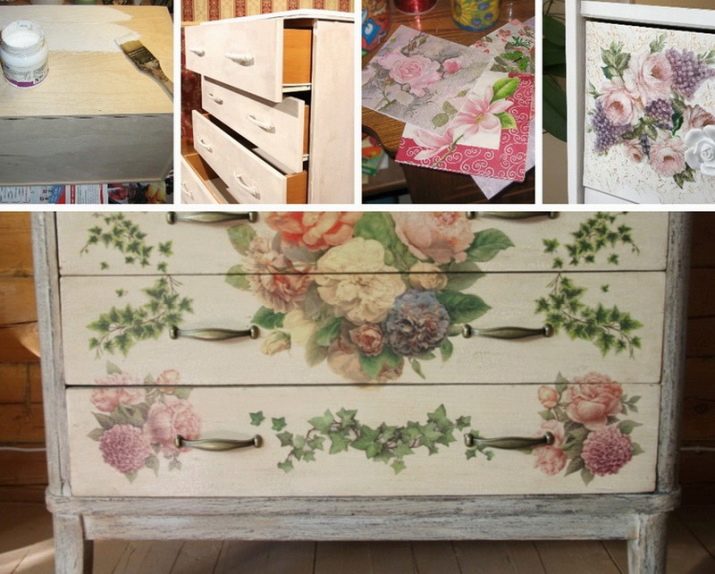
It can become very beautiful and original. bedside tableupdated in decoupage technique. We will analyze step by step how to act in order to achieve a good result.
- First prepare the cabinet for decoration. Wash it thoroughly, sand it, remove all accumulated dust, and then let the material dry. Paint the bedside table with white acrylic paint.
- When the furniture dries, cover it with paint, and then start decorating. You need to prepare napkins with a pattern that you like. Together with napkins you will need: glue, varnish, brushes.
- Decorate the recesses of the furniture. Prints can overlap with other shades of the surrounding interior.
- Now you need to remove the top layer of napkins with flowers. Lay out the nightstand. The interior spaces and drawers can be made more saturated and colorful by treating them with paint of your favorite color.
- The attached napkins will have to dry within 24 hours.
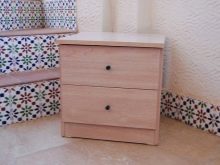
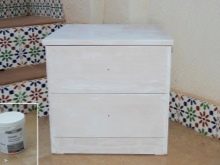
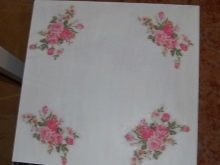
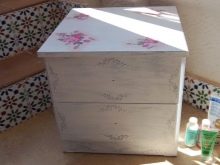

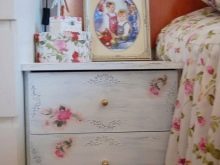
Decoupage technique can be applied regarding stools. If everything is done correctly, the result can be very beautiful and spectacular designs. We will analyze a master class on the processing of such furniture. The following steps must be completed:
- first remove the stool from the legs;
- sand the stool with sandpaper;
- thoroughly wipe the surface of the stool with a cloth soaked in acetone to degrease the surface of the furniture and remove all dust deposits that were formed due to sanding;
- smooth the surface of the stool with special acrylic paint and a brush, apply the layers evenly, it is permissible to apply up to 3-4 layers, apply white color;
- Sand the already painted base again with sandpaper;
- pick up a napkin of the perfect size, lay it on the seat of the stool as it will stick on;
- cover the napkin with a varnish composition, thoroughly coat the corners and edges, smooth out all the uneven elements on the surface of the napkin with a varnish;
- with a piece of clean sandpaper, remove the excess elements of the napkin that fall from the edge of the stool;
- dry the varnish well;
- when the varnish dries, the surface must be sanded again;
- to decorate the sides of the structure, you will need brown gouache and a little varnish; they are combined with each other in small volumes;
- the resulting composition will need to be driven into the sides with a brush; act should be almost dry brush;
- treat the stool with a repeated layer of varnish and dry everything.

You can quickly and easily update an old coffee table. Let’s go through step by step how to do it.
- Prepare the furniture for processing. If it is made of plastic, degrease; if it is made of wood, disassemble and treat with fine-grained sandpaper.
- Apply a primer to the prepared base. When it is completely dry, apply paint in several layers. To form an interesting effect of additional cracking, it is permissible to use a special craquelure varnish.
- Varnish needs to be applied, and then, while it has not yet dried out, apply snow-white acrylic. As soon as it dries, you can begin to glue the selected motive and process everything with colorless varnish, if craquelure is not used. To varnish a coffee table is admissible and varnish in the form of a spray. With this tool, the application will turn out more even and accurate.
- When the varnished layers have dried, you will need to once again go over the old furniture with fine-grained sandpaper to provide better adhesion to the base.
- Prepare sticky napkins. Cut out the necessary pictures with nail scissors. Soak them in water (about 15 minutes), and then put them on a towel to remove excess moisture.
- Decoupage can be done in several ways: hot, dry or wet. If hot decoupage is made, then the cut out pattern is superimposed on the furniture, glued and “passed” on top of it with a hot iron. If the dry method is used, then the motives are glued to the table, and then the remnants of the adhesive composition are removed with cotton wool. The wet method involves impregnating the drawings in diluted glue or varnish, then lay the multifora and carefully transfer it from it to the base.
- When the stage of gluing the images is completed, you need to complete it with additional drawings, adding shadows or tinting. After that, the design should dry thoroughly.
- The varnish must be applied to the table in several layers. To achieve a neat and smooth texture, pour clean water into a separate container, and then moisten a finger there and smooth out the traces of the pile remaining from the brush, while the varnish has not yet dried completely.
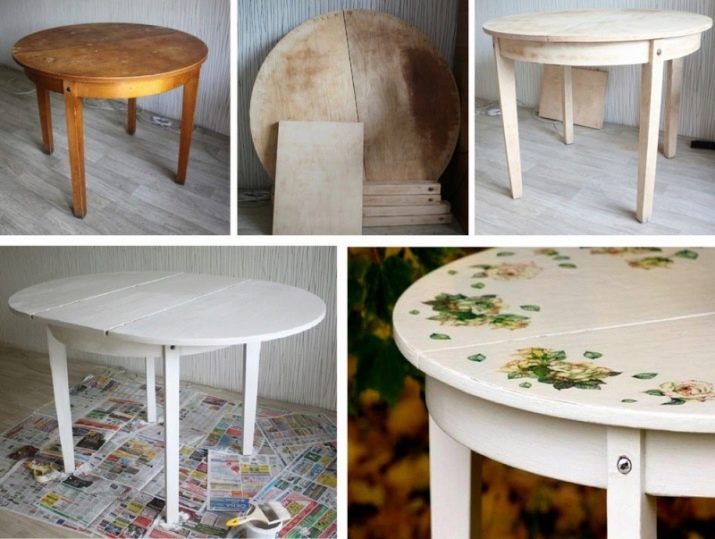
Many housewives prefer to see in their kitchen an original set, decorated using decoupage technique. Here it is permissible to turn to pasting furniture with scraps of old newspapers or magazines. Most masters choose beautiful napkins or wallpapers for decorating kitchen furniture designs.
In such environments, decorative coverings with images of fruits, vegetables, kitchen utensils and other similar things look great. Very often, kitchen headsets are supplemented with rice or mulberry textured paper, especially when it comes to glass elements. For gluing decorative components PVA glue is best.
To achieve a good effect of artificial aging, it is recommended to use acrylic paints, bitumen and paste with a metallic effect.
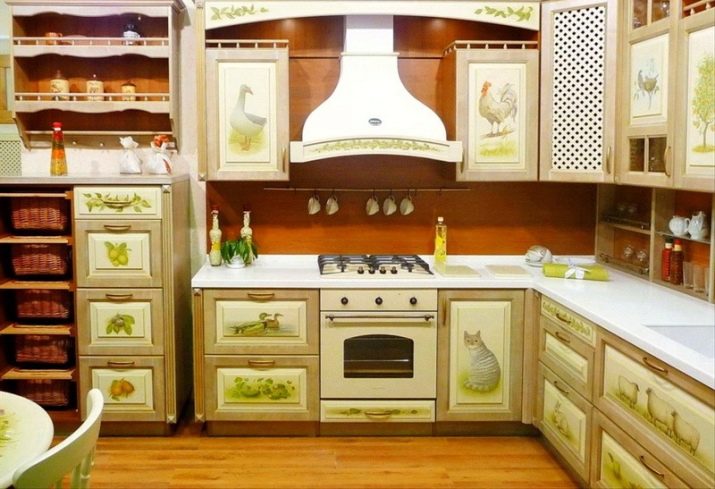
Good examples
Decoupage furniture - a great solution for a house or apartment. With this technique you can realize a variety of creative ideas. This design will be appropriate in any room - in the nursery, bedroom, kitchen, living room.
A vintage chest of drawers painted in pale gray paint and complemented by sticker drawings with birds on the doors will look tender. Of the bright details, there can only be dark elements of the fittings.

An old simple cabinet can be treated with white paint and give it a craquelure effect. Unusual furniture is completed with images of large roses from napkins. The latter should be glued to the upper and lower parts of the structure.
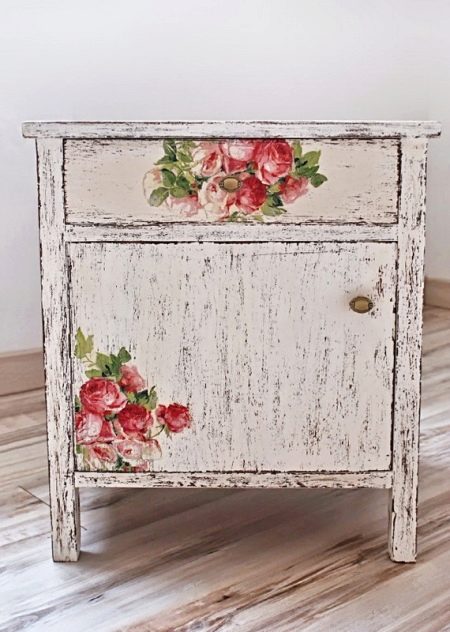
You can decorate furniture using decoupage using stencils. So, on a tall pedestal with several drawers and a cabinet, you can paint it in matt or glossy white, leaving areas intact in the form of large flowers.
During staining, they need to be covered with a stencil.
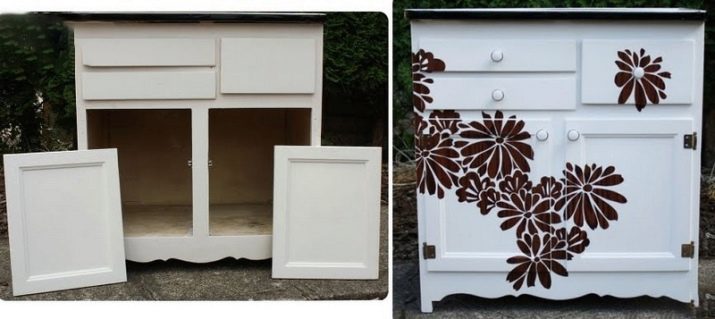
See how to decoupage furniture in the next video.
